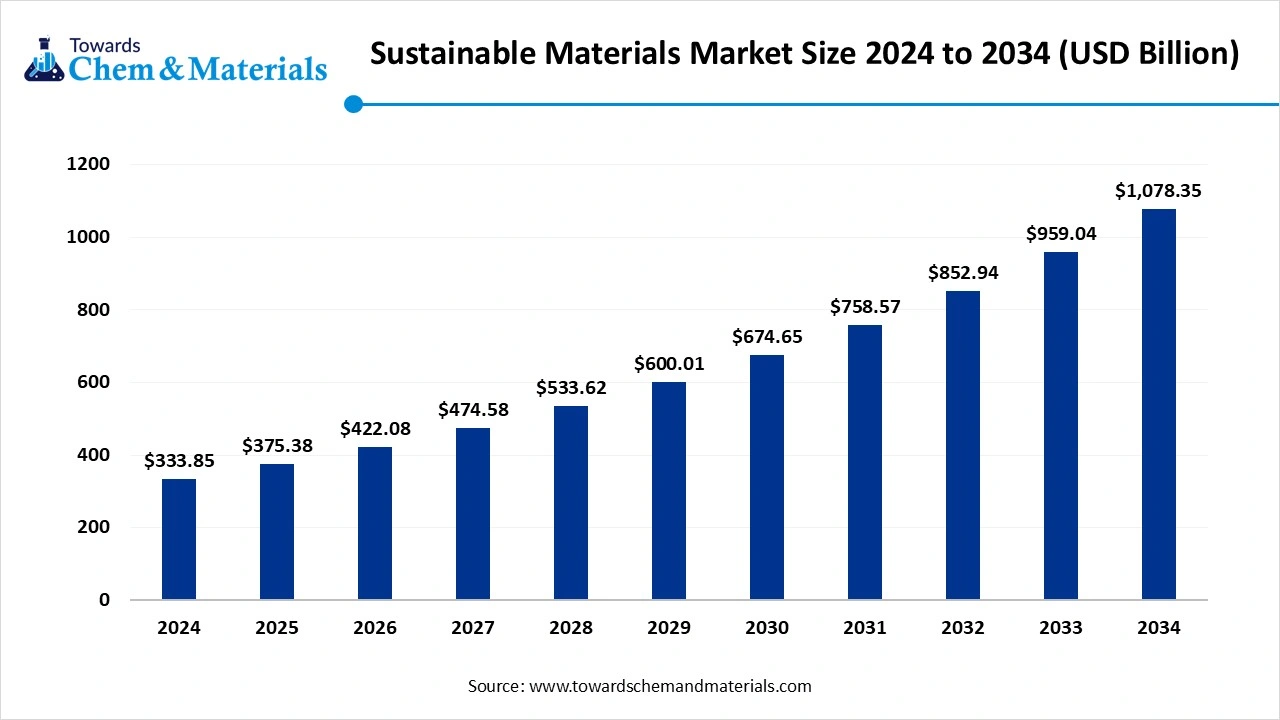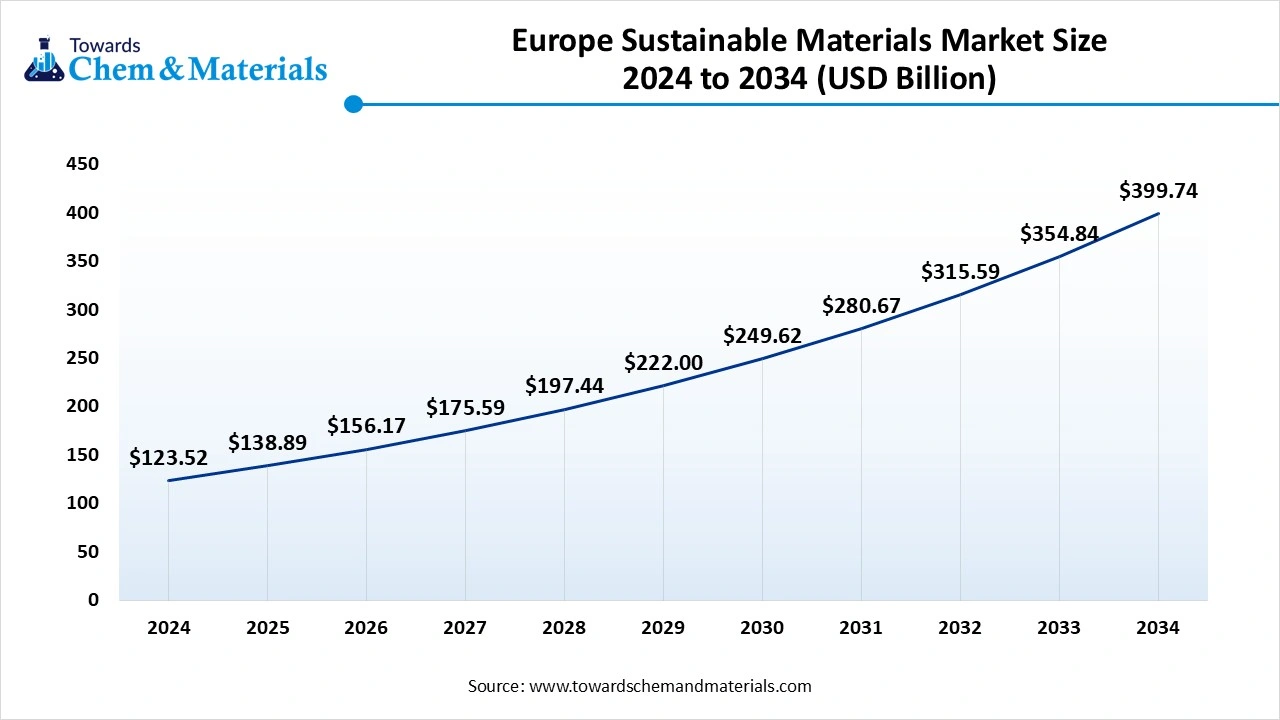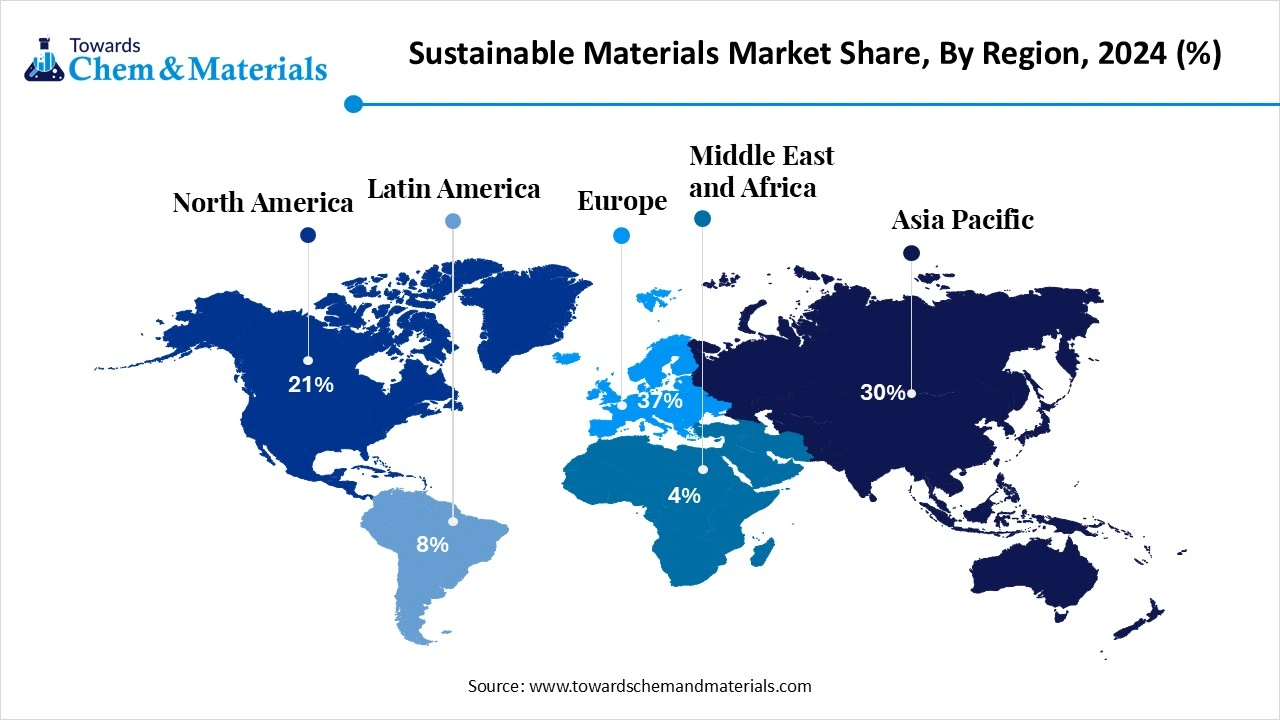December 2025
The global sustainable materials market is exhibited at USD 375.38 billion in 2025 and is projected to hit around USD 1,078.35 billion by 2034, growing at a CAGR of 12.44% during the forecast period 2025 to 2034. the Europe dominated the sustainable materials market with a market share of 37% in 2024. the growth of the market is driven by growing environmental concerns and increased awareness among consumers for the use of sustainable and eco-friendly materials fuels the growth of the market.

Sustainable materials are materials selected, produced and managed to minimise environmental and social harm across their whole life cycle, from raw material sourcing and manufacturing through use to end-of-life. They prioritise renewability, low embodied carbon, recyclability/compostability, reduced toxic inputs, and circular-economy design (repair, reuse, remanufacture and recycling) so that resource use is decoupled from environmental degradation while maintaining required performance.
| Report Attributes | Details |
| Market Size in 2026 | USD 422.08 Billion |
| Expected Size by 2034 | USD 1,078.35 Billion |
| Growth Rate from 2025 to 2034 | CAGR 12.44% |
| Base Year of Estimation | 2024 |
| Forecast Period | 2025 - 2034 |
| Dominant Region | Europe |
| Segment Covered | By Material Type, By Application, By End-Use Industry, By Region |
| Key Companies Profiledk | DuPont de Nemours, Inc. , Covestro AG , Evonik Industries AG , Eastman Chemical Company , Solvay S.A. , Braskem S.A. , NatureWorks LLC , Novamont S.p.A. , Trex Company, Inc. , Stora Enso Oyj , UPM-Kymmene Corporation , Suzano S.A. , Sappi Limited , Toray Industries, Inc. , Corbion N.V. , Amcor plc , Kingfa Sci & Tech Co., Ltd. |
| Region / Country | Regulatory Body | Key Regulations / Frameworks | Focus Areas | Notable Notes |
| United States | Environmental Protection Agency (EPA), U.S. Department of Energy (DOE), U.S. Green Building Council (USGBC), Federal Trade Commission (FTC) | - EPA Safer Choice & Design for the Environment (DfE) - USDA BioPreferred Program (7 CFR Part 3201) - FTC Green Guides (16 CFR Part 260) - Energy Policy Act & LEED Certification |
- Sustainable product certification - Green labelling and bio-based content - Emission and lifecycle impact assessment |
The USDA BioPreferred label supports renewable material use. LEED promotes sustainable building materials. FTC Green Guides regulate environmental marketing claims to prevent greenwashing. |
| European Union | European Commission (DG ENV), European Chemicals Agency (ECHA), European Committee for Standardisation (CEN) | - EU Green Deal (2019) - Circular Economy Action Plan (2020) - Ecodesign for Sustainable Products Regulation (ESPR, proposed 2024) - REACH & CLP Regulations |
- Circular design and recyclability - Material efficiency and durability - Product carbon footprint disclosure |
The EU’s ESPR mandates product-level sustainability performance and digital product passports. REACH ensures safe material composition. Strongest regional focus on carbon-neutral materials. |
| China | Ministry of Ecology and Environment (MEE), National Development and Reform Commission (NDRC), Standardisation Administration of China (SAC) | - Circular Economy Promotion Law (amended 2021) - Green Manufacturing System (GB/T 36132-2018) - GB/T 41010-2021 – Biobased labelling |
- Resource efficiency and recyclability - Industrial energy management - Green product labelling and certification |
China’s Green Factory Initiative promotes sustainable material use in industry. Eco-label certifications apply to low-carbon, renewable, and recyclable products. |
| India | Ministry of Environment, Forest and Climate Change (MoEFCC), Bureau of Indian Standards (BIS), Ministry of Commerce and Industry | - National Resource Efficiency Policy (Draft, 2019) - E-Waste & Plastic Waste Management Rules (2022) - BIS Green Product Certification Scheme |
- Circular economy and resource reuse - EPR for industrial materials - Sustainable certification |
India’s BIS Green Mark certifies eco-friendly materials. EPR mandates extend to plastics, metals, and electronics. National policies encourage renewable and recycled input in manufacturing. |
| Middle East (UAE, Saudi Arabia) | Environment Agency – Abu Dhabi (EAD), Saudi Standards, Metrology and Quality Organization (SASO), Gulf Organization for Industrial Consulting (GOIC) | - UAE Federal Law No. 12 (2018) – Waste Management - Saudi Vision 2030 Circular Economy Framework - SASO 2879:2021 – Biodegradable plastic regulation |
- Sustainable production and recycling - Energy-efficient manufacturing - Bio-based and recyclable materials |
GCC nations promote Vision 2030 green manufacturing. Focus on renewable polymers, recycled metals, and low-carbon building materials. |
Which Material Type Segment Dominated The Sustainable Materials Market in 2024?
The biodegradable plastics segment dominated the market with a share of 36% in 2024. Biodegradable plastics are a key focus area in sustainable materials, offering eco-friendly alternatives to traditional polymers. These materials, derived from starch, PLA, and PHA, decompose naturally and reduce landfill waste. Their adoption is rising in food packaging, agriculture, and consumer goods, supported by global regulations limiting conventional plastic use and increasing end-user awareness of environmental impacts.
The sustainable packaging materials segment expects significant growth in the market during the forecast period. Sustainable packaging materials include paper-based composites, recycled plastics, and bio-based films that enhance circularity in product life cycles. The packaging sector is increasingly adopting such materials to reduce carbon footprints and comply with environmental norms. Companies are investing in recyclable mono-material structures and renewable coatings to meet demand for low-impact, high-performance sustainable packaging solutions.
How Did the Packaging Segment Dominate the Sustainable Materials Market in 2024?
The packaging segment dominated the market with a share of 33% in 2024. The packaging segment dominates the sustainable materials market, with rapid adoption of biodegradable and recyclable options across the FMCG, food, and e-commerce industries. Brand owners are transitioning toward compostable and paper-based packaging to align with green consumer preferences and regulatory compliance. Continuous innovation in lightweight and renewable materials further supports sustainable packaging scalability.
The consumer goods segment expects significant growth in the market during the forecast period. Consumer goods manufacturers are embracing sustainable materials to achieve brand differentiation and regulatory compliance. Applications span personal care, electronics, and household items using recyclable polymers and natural fibres. This shift is propelled by growing consumer demand for eco-conscious products and circular design, encouraging manufacturers to adopt renewable feedstocks and sustainable production methods.
Which Commercial Segment Dominated The Sustainable Materials Market in 2024?
The commercial segment dominated the market with a share of 40% in 2024. In the commercial sector, sustainable materials are used extensively in packaging, furniture, and retail infrastructure. Businesses are adopting bio-composites and recycled plastics to lower operational carbon emissions. Retail chains and service industries emphasise eco-packaging and reusable materials, integrating sustainability goals into procurement and operational strategies for brand responsibility and cost efficiency.
The industrial segment expects significant growth in the market during the forecast period. The industrial segment utilises sustainable materials in manufacturing, automotive, and construction applications. Industries are replacing virgin plastics with bio-based polymers, recycled composites, and low-carbon raw materials to meet ESG compliance and energy efficiency standards. Investments in circular supply chains and green certifications are fostering industrial-scale adoption of eco-friendly materials.
The Europe sustainable materials market size is valued at USD 138.89 billion in 2025 and is expected to surpass around USD 399.74 billion by 2034, expanding at a compound annual growth rate (CAGR) of 12.46% over the forecast period from 2025 to 2034. Europe dominated the market with a share of 37% in 2024. Europe leads the market, driven by stringent environmental regulations, circular economy policies, and strong demand from the packaging and automotive sectors. The EU’s Green Deal and single-use plastics ban have accelerated the shift toward biodegradable polymers and recyclable materials. European manufacturers are increasingly adopting life-cycle assessment (LCA)-based design and closed-loop systems, promoting innovation in compostable packaging, bioplastics, and carbon-neutral materials to meet sustainability targets and consumer expectations for eco-friendly products.

The UK sustainable materials market is characterised by rapid innovation and government-led sustainability programs aimed at achieving net-zero goals. Growing consumer awareness, extended producer responsibility (EPR) regulations, and investments in biobased material startups are enhancing domestic production capacity. Companies are prioritising recyclable packaging and sustainable composites in consumer goods, construction, and retail sectors, while public–private partnerships promote infrastructure for large-scale waste recovery and bio-based material utilisation.
Asia Pacific Sustainable Materials Market Trends
Asia Pacific is expected to have significant growth in the market in the forecast period. Asia Pacific shows strong growth in sustainable materials, fueled by urbanisation, government sustainability initiatives, and expanding consumer demand for green packaging. Major economies such as China, Japan, and South Korea are integrating circular economy frameworks and adopting biodegradable plastics in food packaging and consumer goods. Local producers are scaling bioplastic and recycled material production, while international collaborations accelerate technology transfer, supporting regional self-sufficiency in sustainable resource utilisation.
India Sustainable Materials Market Trends
India’s sustainable materials market is emerging rapidly, supported by government programs such as the Plastic Waste Management Rules and the Make in India initiative. Local startups and packaging manufacturers are investing in biodegradable films, compostable plastics, and fibre-based materials. Growing retail and FMCG sectors drive demand for eco-friendly packaging, while incentives for recycling and renewable raw materials promote industrial adoption and support long-term sustainability goals across manufacturing and logistics.
North America Sustainable Materials Market Analysis
North America is a major market for sustainable materials, driven by corporate sustainability commitments, innovation in bio-based polymers, and policy support for green manufacturing. The U.S. and Canada lead in adopting circular economy principles through public–private collaborations. Demand for compostable packaging, renewable materials, and carbon-neutral supply chains is increasing across automotive, consumer goods, and construction sectors, aligning industrial growth with environmental stewardship.

U.S. Sustainable Materials Market Analysis
The U.S. sustainable materials market benefits from advanced R&D, significant investment in bio-based technology, and regulatory efforts promoting recycling infrastructure. Key industries like packaging, automotive, and construction are transitioning to recyclable and renewable material alternatives. Government funding and corporate ESG initiatives are accelerating the commercialisation of next-generation bioplastics and renewable composites, ensuring sustainable growth within a competitive industrial framework.
By Material Type
By Application
By End-Use Industry
By Region
December 2025
December 2025
December 2025
December 2025